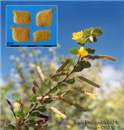Scientific name(s)
Chamaecrista rotundifolia
Strengths
- Grows in soils of low fertility
- Rapid establishment and spread
- High seed yield
- Adapted to acid soils
Limitations
- Low palatability, particularly of young leaves
- Poor drought tolerance if ungrazed
Plant description
Plant: A short-lived, summer growing perennial legume (in wetter environments) or a self-regenerating annual (in drier, frosty environments); herbaceous to slightly woody; prostrate to semi-erect, growing to 1m tall, with a shallow taproot.
Stems: Stems slightly hairy, 45-110 cm long.
Leaves: Rounded with two leaflets
Flowers: Up to three small yellow flowers originating from the leaf axils.
Pods: Flat, straight or slightly curved, up to 6cm long, shattering when mature
Seeds: Seeds small, rectangular, flattened, sometimes pointed on the corners, tan to light brown, 2-3 mm long; 200,000-470,000 seeds/kg.
Pasture type and use
Sown into native pastures to improve feed quality and as a legume component of long term sown grass pastures; colonises readily.
Where it grows
Rainfall
Grows as a perennial in a 900-1,500 mm rainfall region, and as an annual in a 550-900 mm region.
Soils
Free-draining light soils of acid to neutral pH, particularly sands or sandy loams of low to moderate fertility.
Temperature
Summer growing, top growth killed by frost. Where regular heavy frosts occur, round-leaf cassia behaves as an annual.
Establishment
Companion species
Grasses: Indian blue grass, Rhodes grass, Digit grass, Tall finger grass, and any other grasses adapted to lighter soils.
Legumes: Fine stem stylo, Lotononis, joint vetch, serradella, biserrula.
Sowing/planting rates as single species
1 kg/ha
Sowing/planting rates in mixtures
0.5 kg/ha
Sowing time
Spring/summer
Inoculation
Group M; promiscuous but inoculation is recommended.
Fertiliser
Responds to phosphorus and sulphur on soils of low-fertility (based on soil test).
Management
Maintenance fertliser
Phosphorus and sulphur on soils of low-fertility.
Grazing/cutting
Very tolerant of and requires constant heavy grazing, If allowed to grow tall and then 'crash' grazed, individual plants fail to regenerate and die. Populations will regenerate from seed. Not selectively grazed in the young, growing stages but preferred when the leaves are older, often after seed set.
Seed production
Very heavy seed set, but seed ripens over an extended period and shatters. Yields of 800 kg/ha have been harvested using suction harvesting equipment.
Ability to spread
Will spread naturally through seed shattering and in dung after ingestion by livestock.
Weed potential
Large seed set and low seasonal palatability suggest this plant could have weed potential though this is unlikely and has not been observed in drier environments.
Major pests
None known.
Major diseases
None known.
Herbicide susceptibility
Not known; generally not sown in areas where herbicides are used.
Animal production
Feeding value
Good protein and digestibility levels recorded under grazing on fertile soils. Application of P and S on low fertility soils in southern Queensland increased N concentrations of leaf tips to 3.3% N (21% crude protein). 'Wynn' cassia has raised the N concentration of black speargrass by 20-40% under grazing and fertilising (with P & S).
Palatability
Generally not readily eaten by cattle in the growing season under higher rainfall conditions, but becomes more acceptable as the associated grasses mature later in the season. Can comprise up to 20% of the diet in late autumn. Lower seasonal palatability differential in drier areas as plant tissue is generally drier. Not eaten by horses.
Production potential
DM yields of up to 7,000 kg/ha recorded in south-east Queensland but less in drier environments.
Livestock disorders/toxicity
No known anti-nutritional factors.
Cultivars
| Cultivar | Seed source/Information |
| Wynn | Southedge SeedsHeritage SeedsProgressive SeedsAustralian Herbage Plant Cultivars |
Further information
Lloyd, D, O'Brien, S, Johnson, B, Pengelly, B and Wurst, M (2006). Pasture Legumes for Subtropical Grain and pastoral Systems - the Ute Guide (PIRSA, GRDC)
Topical Forages database (SoFT) - Round-leaf cassia; Wynn casia
Better Pastures for the Tropics and Subtropics - Lucerne
Acknowledgements
-
Author and date
Brian Johnson and David Lloyd
December 2008






